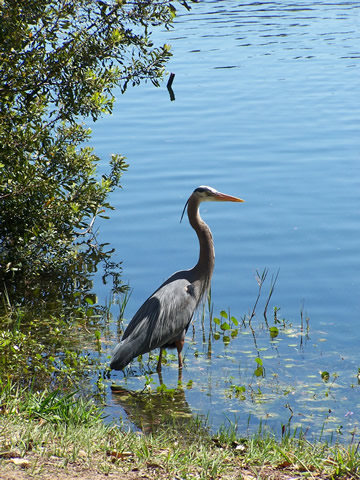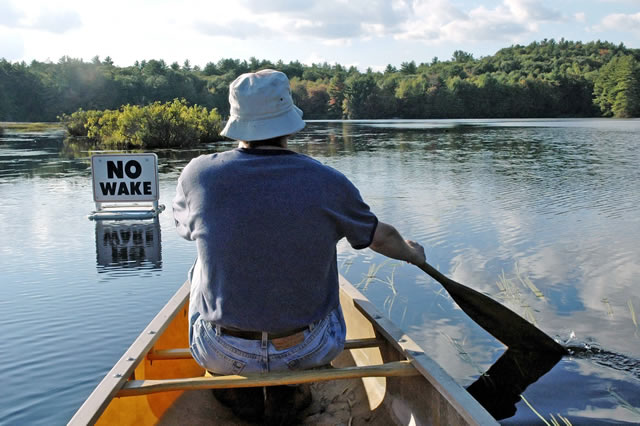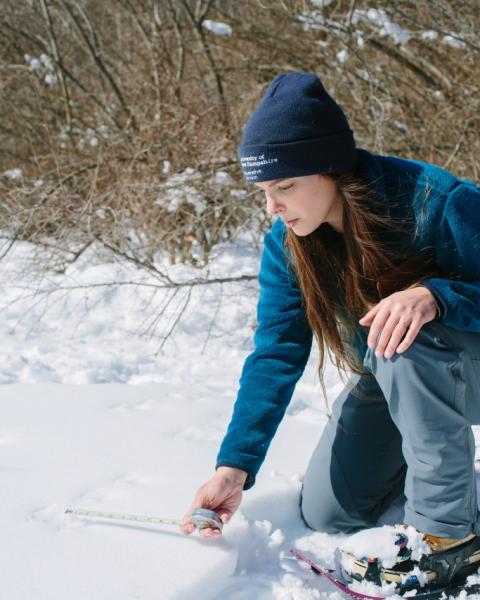The shorelines of lakes, ponds, and rivers are valuable real estate in New Hampshire, but their importance as wildlife habitat is also significant. The qualities that make shorelines attractive to wildlife may be very different from what makes them attractive for boating and swimming.
Shorelines with extensive, mature forests along the shore are critical yet rare habitats in New Hampshire. High quality shorelines are usually found in places undisturbed by buildings, roads, docks, lawns, or heavy recreational activity. At the water’s edge, native aquatic vegetation (plants growing in or under the water), submerged rocks and boulders, and dead trees that have fallen in the water are all features of high quality shoreline habitat. These habitat features become less common as housing density increases around lakes, ponds or rivers.
Underwater vegetation is particularly valuable as cover for wildlife, especially in larger lakes and ponds where wave action or deep water limits the amount of shoreline where plants can grow. Look for plants whose foliage appears to float at the surface or under the water, such as pond lilies, pondweeds, coontail, bladderwort, and native milfoils.
The best shoreline habitat has large areas of diverse underwater vegetation such as coontail and bladderwort mixed with aquatic plants such as pickerelweed and yellow pond lily that grow in scattered stands. When these features are found near deep water, shoreline wetlands, and upland forests, the shoreline habitat becomes a productive hunting ground for great blue and green heron, otter, mink, and larger fish such as eastern chain pickerel and yellow perch.
Why are Shorelines Important?
The quality of shoreline habitat may be the single biggest influence on the abundance and variety of wildlife that live in or around a water body. lakes, ponds and rivers with plentiful natural vegetation and undeveloped shorelines surrounded by large blocks of forest will support the greatest number of wildlife species. By comparison, water bodies dominated by docks, stabilized banks, lawns, beaches, houses, and heavy boat traffic support far fewer wildlife species.
Water quality protection
Pollution from widespread sources like roads, houses, and cars (as opposed to factories and other “point sources”) is the number one threat to water quality in lakes and ponds in New Hampshire. Native shrubs and trees growing along shorelines help protect the water from soil erosion, runoff, pesticides, chemicals, and excess nutrients. These pollutants kill fish, promote the growth of aquatic weeds, and muddy the water, all of which diminish the value of the lake, pond
or river for homeowners, boaters, anglers, swimmers, and wildlife alike. Once a lake, pond, or river has been degraded, it can be difficult to restore its quality. Learn more: NH Lakes Management & Protection, NH Rivers Protection
 Natural vegetation
Natural vegetation
Land along shorelines is critical wildlife habitat. Loons need undisturbed shoreline for nesting at the water’s edge. Warbling vireos and song sparrows nest in the branches of shoreline trees and shrubs, and common mergansers use hollows in dead trees. Even trees and shrubs in front of a home can provide valuable cover for passing animals and minimize disturbance to ducks and loons swimming by. Forested shorelines allow forest animals such as moose or raccoons to use the water and food available at the shore.
Dead trees in the water provide habitat for young and adult sunfish, and underwater branches serve as attachment sites for pickerel frog and green frog eggs. Partially submerged tree trunks make excellent sunning spots for painted turtles. Important as it is for wildlife, downed wood from fallen trees is a rare habitat element on developed shorelines, as it’s usually removed as an impediment to boating and swimming. Some bare shorelines, such as those along large, fast moving rivers that are regularly scoured by water and ice, can still be important habitat for wildlife such as dragonfly larvae, bluegills and freshwater mussels.
Rich breeding grounds
Coves and shallow areas with aquatic vegetation are used as nursery and spawning habitat for many fish, including the state-threatened bridle shiner. A lack of vegetation will ultimately affect fish diversity in a lake or pond. Young fish, insects, and amphibians living in shoreline habitats attract hawks, herons, ducks, mink, raccoons, and northern water snakes which all forage along shorelines. Predatory fish, including bass, pickerel, pike, and creek chubsuckers all forage in aquatic vegetation. Sunfish spawn in circular depressions in shallow water and crayfish are abundant in rocky shallows. Lake shores and shallow ponds are also the home of musk turtles, painted turtles, and snapping turtles. Aquatic plants provide cover for aquatic invertebrates such as snails and dragonfly larvae, which are in turn fed upon by fish and other predators. Filter-feeding freshwater mussels burrow in the fine silt trapped by aquatic plants.
Threats by invasive plants
Invasive plants such as variable milfoil and fanwort threaten the diversity of plants and wildlife in New Hampshire. Invasive plants take over native vegetation and offer less-valuable habitat and food sources for many species of wildlife. When large mats of invasive plants die, they deplete the water of oxygen, which also threatens wildlife. Learn more about aquatic invasive plants.
Climate Vulnerabilties Along Shorelines
- Changes in precipitation patterns, such as longer periods of drought, unpredictable large storms, higher flows, and run-off events.
- Increased mechanical alteration of habitat, including erosion, higher energy flooding, and ice scour along rivershores.
- Increased risk from invasion by invasive species.
- High wind and excessive wave energy along lake beaches and shorelines.
Click here for the Lakeshore and Rivershore Climate Assessment, a section of the Ecosystems and Wildlife Climate Change Adaptation Plan (2013), an Amendment to the NH Wildlife Action Plan
Wildlife Found Along Shorelines
The wildlife species listed here are closely associated with shoreline habitats, but many other species will use shorelines at some time during the year. Be on the lookout for these and other species that use shorelines, and follow stewardship guidelines to help maintain or enhance these habitats. species of conservation concern—those wildlife species identified in the wildlife action plan as having the greatest need of conservation—link to their NH Wildlife Action Plan species profiles.
- Bald eagle*
- Bank swallow
- Banded sunfish
- Belted kingfisher
- Bridle shiner*
- Bullfrog
 Common loon*
Common loon*- Common merganser
- Crayfish
- Dragonflies & damselflies
- Eastern chain pickerel
- Eastern kingbird
- Eastern pond mussel
- Eastern spotted newt
- Great blue heron
- Mink
- Moose
- Musk turtle
- Northern harrier**
- Nothern water snake
- Osprey
- Otter
- Painted turtle
- Raccoon
- Redfin pickerel
- Ring-billed gull
- Spotted sandpiper
- Snapping turtle
- Warbling vireo
- White sucker
- Wood turtle
- Yellow perch
*state-threatened species
**state-endangered species
Stewardship Guidelines for Shoreline Habitats
- Conserving land from additional development around shorelines is critical for maintaining healthy lake and river ecosystems, as these are some of our most degraded habitats. Land conservation of these high-value properties requires strong and stable public and non-profit funding, community partnerships, and financial investment by landowners and voters.
- Landowners around lakes, ponds and rivers should understand and follow all laws pertaining to the development, alteration, or cutting of vegetation along shorelines, including the Comprehensive Shoreland Protection Act.
- Existing New Hampshire shoreline laws don’t explicitly protect wildlife habitat. Responsibility for protecting and restoring wildlife habitat rests instead with individual shorefront property owners. If every shoreline owner maintained a portion of their shoreline for wildlife habitat, it would have huge benefits for fish, wildlife, water quality and the aesthetics of our lakes, ponds and rivers. Two publications by UNH Cooperative Extension can help shoreline landowners find the right balance for their property: Landscaping at the Water’s Edge, and Integrated Landscaping: Following Nature’s Lead. Other recommendations include:

- Leave forest undisturbed within at least 100 feet of the shoreline,
- Retain views by cutting tree branches at view level, leaving the forest floor as undisturbed as possible,
- Loons, eagles, and other large wildlife will benefit from 300 feet of undisturbed forest along shorelines,
- On land, leave standing dead and downed trees for nesting and perching wildlife,
- In the water, leave fallen trees, aquatic plants, and large boulders to provide habitat for aquatic wildlife.
- Winter draw-downs happen on many lakes and ponds to allow for work on docks or to prevent flooding. These water fluctuations can negatively affect wildlife. Freezing temperatures destroy the roots of aquatic plants. Sudden draw-downs may destroy the eggs of fish and adult amphibians. Owners should work with other landowners and lake associations towards management policies that benefit the ecology of the lake or pond.
 The eroding force of boat wakes can destroy sensitive shoreline habitat. Plants rooted in fine sandy bottoms are especially vulnerable to waves. Especially on large rivers, boat wakes can disrupt and kill dragonflies as they emerge from their larval stage underwater. Boaters should be aware of their effect on shoreline habitat and reduce their speed near coves or shallow water.
The eroding force of boat wakes can destroy sensitive shoreline habitat. Plants rooted in fine sandy bottoms are especially vulnerable to waves. Especially on large rivers, boat wakes can disrupt and kill dragonflies as they emerge from their larval stage underwater. Boaters should be aware of their effect on shoreline habitat and reduce their speed near coves or shallow water.- Installing a dock requires a permit and should be done with minimal disturbance of aquatic vegetation. Consider partnering with neighbors on jointly-owned docks to help reduce the number of man-made structures along the shore.
- Avoid the use of fertilizers, lime, pesticides and herbicides near any water body, and follow all laws, including the Comprehensive Shoreland Protection Act, related to the use of these substances. Many pesticides and herbicides are toxic to aquatic organisms. Excess fertilizer also threatens wildlife and water quality through a process called “eutrophication.” Excess nutrients from fertilizers increase algae growth which clouds the water. The algae then die and decompose, causing a drop in oxygen in the water, which in turn can lead to large-scale fish die-offs.
- Help stop the spread of invasive aquatic plants. Always inspect your boat, motor, trailer, and recreational equipment for tag-along plants before launching and after exiting a lake, pond or river. Remove all tag-along plants and dispose of them away from the waterbody.
- Man-made ponds are a poor substitute for natural ponds and lakes. However, landowners can improve the habitat and water quality of man-made ponds by following stewardship recommendations for natural shorelines.
Additional Resources for Shorelines
- Habitat Stewardship Brochure for Shorelines: order hard copy
- Landscaping at the Water's Edge - from UNH Cooperative Extension
- Integrated Landscaping: Following Nature’s Lead - from UNH Cooperative Extension
- NH Dept. of Environmental Services: Shoreland Program
- NH Dept. of Environmental Services - Lakes Management & Protection Program
- NH Dept. of Environmental Services - Rivers Management & Protection Program
Photo Credits this page: Michael Marchand, NH Fish & Game Department; Lindsay Webb, NH Fish & Game; Ben Kimball, NH Natural Heritage Bureau; Steve Maslowski, USFWS Archives.
Research for this webpage and accompanying Habitat Stewardship brochures was conducted by UNH Cooperative Extension staff with support from the Sustainable Forestry Initiative and NH Fish & Game
